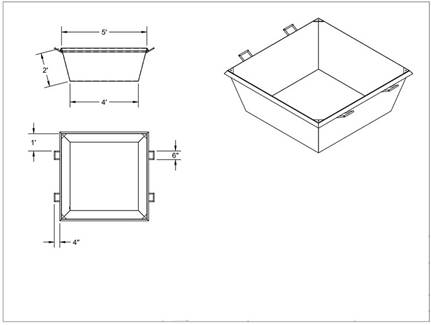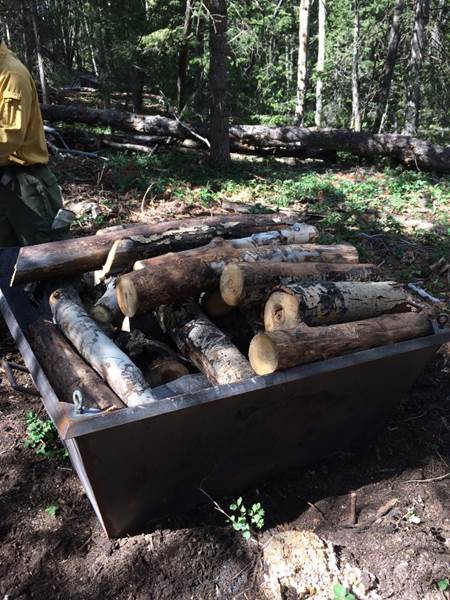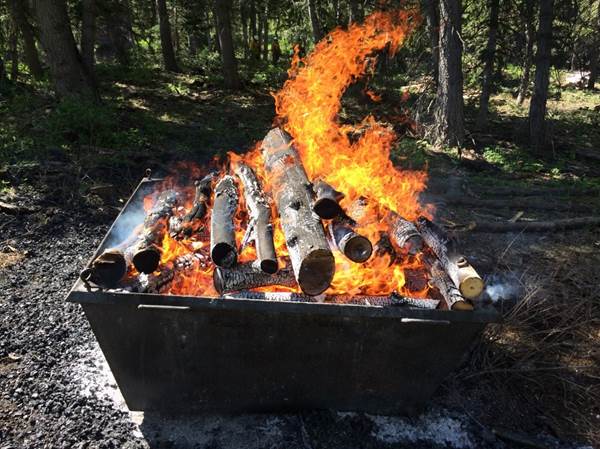 |
June 2020
|
June 2020 // Volume 58 // Number 3 // Ideas at Work // v58-3iw5
Hosting Flame Cap Biochar Kiln Workshops to Teach Hazardous Fuel Reduction
Abstract
The combination of large volumes of woody fuel needing disposal after forestry activities and evolving regulatory restrictions makes traditional methods of pile burning increasingly difficult. Alternatively, using small kilns to pyrolyze these fuels on-site yields a potentially valuable product: biochar. In this article, we describe an educational program on the use of small kilns for fuel treatment and biochar production. Survey results from our series of demonstrations indicate that 69% of respondents added biochar to their soils and 100% of respondents increased their interest in biochar. Moreover, we reduced hazardous fuel in Utah by more than 20 semitruck loads by implementing this approach.
Introduction
Hazardous fuels are a problem across the West. From 2000 to 2017, bark beetles affected 85,000 mi2 of forests in the western United States (an area the size of Utah) (Katz, 2017). Consequently, wood disposal and hazardous forest fuel accumulation are common challenges faced by forest landowners, professional foresters, land managers, and wildland firefighters. Arborists and gardeners also are interested in alternative means for treating woody fuels. People with these diverse interests are enthusiastic audiences for flame cap biochar kiln workshops. Flame cap kilns are simple open-topped metal boxes constituting an accessible tool for reducing waste wood and hazardous fuel while producing biochar, a carbon-rich soil amendment. The potential for using these kilns provides Extension educators opportunities to conduct workshops that
- reach diverse audiences with a hands-on experience;
- provide education on hazardous fuel reduction, wildland fire hazard, soil health, and carbon sequestration; and
- attract gardeners and farmers interested in amending their soils with carbon-rich biochar.
Although piling and burning waste wood is an economical means for disposing of waste wood, challenges exist. In a state where air temperature inversions are common, air quality restrictions and longer fire seasons have made pile burning more difficult over the past 30 years (Hessburg, Reynolds, Keane, James, & Salter, 2007). In some cases, pyrolyzing this material close to the supply of biomass (as is the practice with the flame cap kiln technique) provides a better disposal alternative (Busse, Shestak, & Hubbert, 2013). Flame cap kiln workshops are an accessible platform through which Extension educators can teach clientele how to produce biochar (McAvoy, Dettenmaier, & Kuhns, 2018). We conducted such workshops and provide herein information for others interested in doing so.
Preparing to Conduct a Flame Cap Kiln Workshop
Preparation is key to a successful flame cap kiln workshop. Start by identifying partners; in Utah we relied on county Extension agents, state forestry personnel, federal foresters, rural and wildland firefighters, forestry company representatives, and private landowners. Depend on these people to help you
- choose accessible and conveniently located sites with plenty of parking space,
- access private and agency lands,
- obtain burning permits, and
- enlist audiences.
For us, the funding to purchase kilns and conduct the associated workshops came from a Utah State University Extension seed grant. Kilns can be made or repurposed from a variety of materials; we chose to use the flame cap kiln design shown in Figure 1. Welding shops in Utah manufacture these 14-gauge steel kilns for approximately $800. Instruction for building a kiln is not part of our workshop, but we share the blueprints shown in Figure 1 with audience members during the workshop. You should have a kiln built prior to hosting a workshop.
Figure 1.
Kiln Design

Note. Figure credit: Kelpie Wilson, Backyard Biochar.
A single firing of the kiln can consume five times the volume of the kiln; therefore, make sure you have enough feedstock on hand. Work with your partners to prepare biomass by
- cutting branches and logs 1 ft smaller than the kiln;
- sorting material into distinct piles of logs, medium-sized branches, and fine material or kindling; and
- making sure the feedstock is not newly cut as the material should be dry and cured to ensure the cleanest burn possible.
Safety is the most important consideration when conducting flame cap kiln workshops; contact local fire authorities to assist you in preventing unwanted fire. Always have a hose charged with a water supply ready to deal with escaped embers. Have available appropriate fire tools, such as shovels, rakes, axes, and chainsaws, for clearing fire lines and preventing an unwanted ignition. Ask participants to wear clothing made of natural cotton or wool fibers and to avoid wearing flammable polyester materials. Personal protective equipment should include leather gloves and boots, eyewear, and possibly a hard hat. In Utah, trained, off-season wildland firefighters are often the individuals helping conduct the demonstrations, providing an added layer of fire safety during the workshops.
Step-by-Step Biochar Production Guide
In conducting the workshop, demonstrate the following steps:
- Place the kiln on a flat surface away from structures or vegetation, including overhead branches and power lines.
- Fill the kiln with dry branches and logs up to 6 in. in diameter, piling layers in a crisscross pattern (see Figure 2).
- Pile small, dry sticks (kindling) on top.
- Light the kiln from the top.
- Keep adding material as it burns down until the kiln is at least three quarters full of coals.
- When the flames die down from flaming combustion (see Figure 3) to glowing or smoldering combustion (see Figure 4), quench the fire by adding enough water to wet all materials.
- Stir vigorously with rakes and shovels to ensure that everything is wet and extinguished.
- To prevent fire escape, make sure all material is cool to the touch.
- Dump the kiln out.
- Distribute the biochar onto the forest floor or collect it for gardening or agricultural applications.
Figure 2.
Rick of Logs

Note. Figure credit: Darren McAvoy, Utah State University Forestry Extension.
Figure 3.
Flaming Combustion

Note. Figure credit: Darren McAvoy, Utah State University Forestry Extension.
Figure 4.
Glowing Combustion

Note. Figure credit: Darren McAvoy, Utah State University Forestry Extension.
Demonstration Impacts
To understand how our workshops affected behaviors, we conducted a survey 6 months after one of the demonstrations. We found that
- 69% of respondents had added biochar to soils,
- 78% of respondents had increased knowledge about biochar, and
- 100% of respondents had increased interest in biochar.
We have conducted seven flame cap kiln workshops in Utah to date, with a total of 228 participants. As well, we have reduced hazardous fuel in Utah by more than 20 semitruck loads.
Hands-on demonstrations encourage people to take action with wood-based biofuels projects (Moroney, Laninga, & Brooks, 2016). Our findings underscore significant workshop impacts as well as the potential to expand biomass disposal options in Utah. Flame cap biochar kiln workshops are a practical approach Extension educators can use to teach clientele about hazardous fuel reduction and biochar production.
Acknowledgment
Kelpie Wilson (Wilson Biochar Associates, Cave Junction, Oregon) conducted our first workshop on May 17, 2017.
References
Busse, M., Shestak, C., & Hubbert, K. (2013). Soil heating during burning of forest slash piles and wood piles. International Journal of Wildland Fire, 22(6). Retrieved from http://www.publish.csiro.au/wf/pdf/WF12179
Hessburg, P., Reynolds, K., Keane, R., James, K., & Salter, R. (2007). Evaluating wildland fire danger and prioritizing vegetation and fuels treatments. Forest Ecology and Management, 247(1–3), 1–17. Retrieved from https://www.sciencedirect.com/science/article/pii/S0378112707002320
Katz, C. (2017, September 21). Small pests, big problems: The global spread of bark beetles. Yale Environment 360. Retrieved from https://e360.yale.edu/features/small-pests-big-problems-the-global-spread-of-bark-beetles
McAvoy, D. J., Dettenmaier, M., & Kuhns, M., (2018). Mobile pyrolysis for hazardous fuels reduction and biochar production in western forests. Journal of Extension, 56(1), Article v56-1iw3. Available at: https://www.joe.org/joe/2018february/iw3.php
Moroney, J., Laninga, T., & Brooks, R. (2016). Slash and learn: Revealing stakeholder knowledge, support, and preferred communication methods relative to wood-based biofuels projects. Journal of Extension, 54(5), Article v54-5rb10. Available at: https://www.joe.org/joe/2016october/rb10.php




